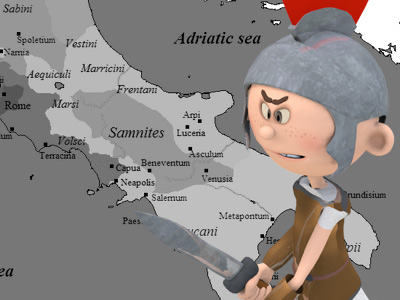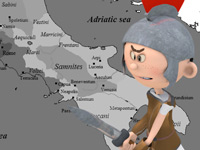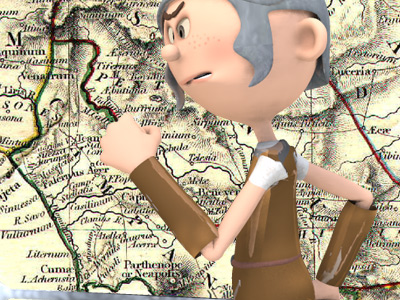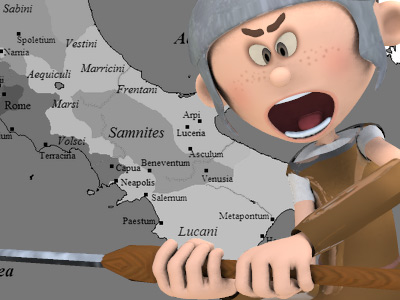Second Samnite War (326-304 BC)

321-316 BC At the Caudine Forks
In 321 BC the consuls Titus Veturius Calvinus and Spurius Postumius Albinus were encamped in Calatia (a Campanian town 10 km southeast of Capua). Gaius Pontius, the commander of the Samnites, placed his army at the Caudine Forks and sent some soldiers disguised as shepherds grazing their flock towards Calatia. Their mission was to spread the misinformation that the Samnites were about to attack the city of Luceria in Apulia, which was an ally of Rome.
The consuls decided to march to the aid of this city and to take the quicker (but less safe) route through the Caudine Forks. These were two narrow and wooded defiles on the Apennine Mountains with a plain between them. The passage from the first to the second defile was a narrow and difficult ravine. The Samnites blocked this with felled trees and boulders. When the Romans The Roman Republic was a form of government of Rome and the era of the classical Roman civilization when it was run through public representation of the Roman people. Beginning with the overthrow of the Roman Kingdom (traditionally dated to 509 BC) and ending in 27 BC with the establishment of the Roman Empire, Rome's control rapidly expanded during this period - from the city's immediate surroundings to hegemony over the entire Mediterranean world. passed through, they also barraged the rear entry to the defile. The Romans were stuck and surrounded by the enemy and set up a fortified camp. Gaius Pontius sent a messenger to his father Herennius, a retired statesman, to ask for advice. His council was to free the Romans immediately. Gaius rejected this and Herenius’ second message was to kill them all. With these contradictory responses Gaius thought that his father had gone senile, but summoned him to the Forks. Herennius said that the first option would lead to peace and friendship with Rome and that with the second one, the loss of two armies would neutralise the Romans for a long time. When asked about a middle course of letting them go and imposing terms on Rome, he said that this "neither wins men friends nor rids them of their enemies." Shaming the Romans would lead them to seek revenge. Gaius decided to demand the Romans to surrender, "evacuate the Samnite territory and withdraw their colonies." The consuls had no choice but to surrender. The Roman soldiers came out of their camp unarmed, underwent the humiliation of passing under the yoke and suffered the mockery of the enemy. The yoke was a symbol of subjugation in which the defeated soldiers had to bow and pass under a yoke used for oxen in disgrace. According to Appian, Pontius used spears as a yoke: "Pontius opened a passage from the defile, and having fixed two spears in the ground and laid another across the top, caused the Romans to go under it as they passed out, one by one."
The Roman Republic was a form of government of Rome and the era of the classical Roman civilization when it was run through public representation of the Roman people. Beginning with the overthrow of the Roman Kingdom (traditionally dated to 509 BC) and ending in 27 BC with the establishment of the Roman Empire, Rome's control rapidly expanded during this period - from the city's immediate surroundings to hegemony over the entire Mediterranean world. passed through, they also barraged the rear entry to the defile. The Romans were stuck and surrounded by the enemy and set up a fortified camp. Gaius Pontius sent a messenger to his father Herennius, a retired statesman, to ask for advice. His council was to free the Romans immediately. Gaius rejected this and Herenius’ second message was to kill them all. With these contradictory responses Gaius thought that his father had gone senile, but summoned him to the Forks. Herennius said that the first option would lead to peace and friendship with Rome and that with the second one, the loss of two armies would neutralise the Romans for a long time. When asked about a middle course of letting them go and imposing terms on Rome, he said that this "neither wins men friends nor rids them of their enemies." Shaming the Romans would lead them to seek revenge. Gaius decided to demand the Romans to surrender, "evacuate the Samnite territory and withdraw their colonies." The consuls had no choice but to surrender. The Roman soldiers came out of their camp unarmed, underwent the humiliation of passing under the yoke and suffered the mockery of the enemy. The yoke was a symbol of subjugation in which the defeated soldiers had to bow and pass under a yoke used for oxen in disgrace. According to Appian, Pontius used spears as a yoke: "Pontius opened a passage from the defile, and having fixed two spears in the ground and laid another across the top, caused the Romans to go under it as they passed out, one by one."

A Lucanian tomb painting of the Battle of the Caudine Forks

A Lucanian tomb painting of the Battle of the Caudine Forks
( Click image to enlarge)
Livy and other ancient sources maintain that Rome rejected the truce offered by the Samnites and avenged the humiliation with victories. Livy said that there was a two-year truce following victories in 320–319 BC. However, Salmon thinks that, instead, the truce was the result of the agreement which was made at the Caudine Forks. Whatever the case, there was a truce which ended in 316 BC.
Livy wrote that regarding the demands of the Samnites (which in Rome they called the Caudine peace), the consuls said that they were in no position to agree a treaty because this had to be authorised by the vote of the people of Rome and ratified by the fetials (priest-ambassadors) following the proper religious rites. Therefore, instead of a treaty there was a guarantee, the guarantors being the consuls, the officers of the two armies and the quaestors. Six hundred equites (equestrians) were handed over as hostages "whose lives were to be forfeit if the Romans should fail to keep the terms." The dejected Roman soldiers left and were too ashamed to enter Capua, whose inhabitants gave them supplies in commiseration. In Rome people went into mourning, shops were closed and all activities at the Forum were suspended. There was anger towards the soldiers and suggestions to bar them. However, when they arrived people took pity on them. They locked themselves in their homes. Spurius Postumius said to the senate that Rome was not bound to the guarantee at the Caudine Forks because it was given without the authorisation of the people, that there was no impediment to resuming the war and all that Rome owed to the Samnites were the persons and the lives of the guarantors. An army, the fetials and the guarantors to be surrendered were sent to Samnium. Once there, Postumius jostled the knee of a fetial and claimed that he was a Samnite who had violated diplomatic rules. Gaius Pontius denounced Roman duplicity and declared that he deemed the Roman guarantors not to be surrendered. The peace he had hoped for did not materialise. Meanwhile, Satricum (a town in Latium) defected to the Samnites and the Samnites took Fregellae.
In 320 BC the consul Quintus Publilius Philo and Lucius Papirius Cursor marched to Apulia. This move threw the Samnites off. Publilius headed for Luceria, where the Roman hostages were held. He routed a Samnite contingent. However, the Samnites regrouped and besieged the Romans outside Luceria. The army of Papirius advanced along the coast as far as Arpi. The people of that area were well disposed towards the Romans because they were fed up with years of Samnite raids. They supplied the besieged Romans with corn. This forced the Samnites to engage Papirius. There was an indecisive battle and Papirius besieged the Samnites who then surrendered and passed under the yoke. Luceria was taken and the Roman hostages were freed.
In 319 BC the consul Quintus Aemilius Barbula seized Ferentium and Quintus Publilius subdued Satricum, which had rebelled and had hosted a Samnite garrison. In 318 BC envoys from Samnite cities went to Rome to "seek a renewal of the treaty." This was turned down, but a two-year truce was granted. The Apulian cities of Teanum and Canusium submitted to Rome and Apulia was now subdued. In 317 BC Quintus Aemilius Barbula took Nerulum in Lucania.
HISTORY

RESOURCES
This article uses material from the Wikipedia article "Samnite Wars", which is released under the Creative Commons Attribution-Share-Alike License 3.0.
© Stories Preschool. All Rights Reserved.











